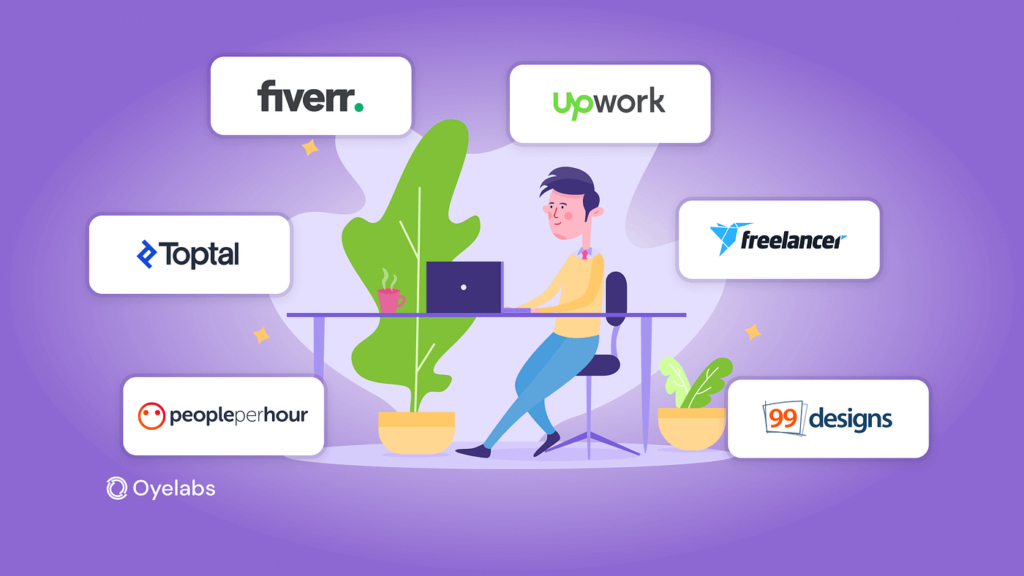Starting a freelancing profession can sense overwhelming at major, but with the correct attitude and mindset, you can set yourself up for attainment. Freelancing offers springiness, independence, and the occasion to pursue your passions. This controller will walk you through the indispensable steps to assistance you begin your freelancing journey with sureness.
Why Choose Freelancing?
Freelancing is attractive a progressively popular profession option for many. Here’s why:
- Flexibility: Set your own calendar and work when it outfits you.
- Project Control: Choose the tasks you enjoy and are passionate about.
- Remote Work: Say goodbye to travelling and save time and cash.
- Unlimited Earning Potential: Scale your revenue based on the work you income on.
Freelancing is impeccable for those who price individuality and want to escape the traditional 9-to-5 drudge.

Steps to Kickstart Your Freelancing Career
1. Identify Your Skills
Before diving into freelancing, take time to identify the skills you excel at. Ask yourself: What can I offer to clients? Some common freelancing skills include:
- Writing
- Graphic design
- Programming
- Digital marketing
- Video editing
Think about where you have the most expertise and where there’s demand in the market.
2. Choose a Niche
Specializing in a position helps you attitude out from the opposition. For example:
- Instead of being a general writer, focus on technical writing or SEO copywriting.
- As a exclusive, concentrate in UI/UX design or brand identity.
By concentrating on a specific niche, you can situation yourself as an skilled in that area, making it easier to appeal customers.
3. Create a Portfolio
Customers want to see examples of your effort. Even if you’re just starting, create sample projects that demonstrate your skills:
- Write a few blog posts or articles.
- Design mockups for websites or logos.
- Develop a simple app or website.
Your assortment is your first impress, so make sure it’s specialized, showcases your best work, and supports with the type of clients you want to invite.
4. Set Your Rates
Pricing can be problematic, especially when you’re opening out. To set your rates, reflect:
- Your experience level.
- The complexity of the work you’re offering.
- Market demand for your services.
Start with competitive rates based on industry standards, and gradually raise your prices as you gain more experience and expertise.
5. Join Freelance Platforms
Freelance platforms can help connect you with clients looking for your services. Some popular sites include:
- Upwork
- Fiverr
- Freelancer
- Toptal

Make a proficient profile that highlights your services, portfolio, and involvement. These stages can help you get your first few customers and build a character.
6. Build a Network
Networking is key to finding freelance opportunities. Build relationships by:
- Joining online communities related to your niche.
- Participating in LinkedIn groups and other professional networks.
- Engaging in forums or social media groups where your board customers hang out.
Connections can main to referrals and new occasions.
7. Market Yourself
As a service provider, you necessity to be your own chief advocate. Here are some stratagems to market you:
- Share your work on social media stages like LinkedIn, Instagram, and Twitter.
- Start a blog or YouTube channel to showcase your expertise.
- Cold email potential clients offering your services.
Consistent self-promotion will help you gain visibility and attract more clients.
8. Learn Time Management
Freelancing requires self-control and effective time managing. Use tools similar to:
- Trello for task management.
- Toggl for time tracking.
- Google Calendar for scheduling.
Proper time organization will help you stay organized, meet limits, and avoid burnout.
9. Communicate Clearly
Effective communication is crucial to freelancing success. Always:
- Clarify project details before starting work.
- Set clear expectations concerning timelines, deliverables, and payment.
- Provide regular updates to customers to possess them in the loop.
Clear statement builds belief and helps sidestep misunderstandings.
10. Keep Learning
The freelancing landscape is constantly evolving. Stay competitive by:
- Taking online courses to improve your skills.
- Attending webinars and conferences in your industry.
- Reading blogs and possession up with leanings.
Continuous knowledge helps you stay relevant and increase your profession prospects.
Summary Table of Freelancing Tips
| Tip | Why It Matters | How to Implement |
| Identify Skills | Leverages your strengths | List your talents and research market demand |
| Choose a Niche | Differentiates you from competitors | Focus on a specific area to establish expertise |
| Build Portfolio | Demonstrates your abilities | Create sample projects to showcase your work |
| Set Rates | Aligns client expectations with your pricing | Research the market and adjust your rates accordingly |
| Join Platforms | Connects you with clients | Sign up for popular freelance sites and optimize your profile |
| Network | Expands your opportunities | Join niche communities and engage with others |
| Market Yourself | Attracts new clients | Share your work on social media and reach out to prospects |
| Manage Time | Ensures timely delivery of projects | Use task management and time tracking tools |
| Communicate Clearly | Builds trust and avoids conflicts | Clarify details, set expectations, and update clients regularly |
| Keep Learning | Keeps you competitive | Take courses, attend events, and stay informed |
Common Challenges Freelancers Face
1. Finding Clients
It may take time to land your first few clients. Be patient, stay proactive, and keep refining your outreach strategies.
2. Managing Finances
Freelancers often face inconsistent income. Use budgeting tools and set aside emergency funds to handle lean periods.
3. Handling Rejection
Not every proposal or pitch will lead to a job. Use rejections as learning opportunities to improve your approach.
4. Balancing Workload
It’s easy to overload yourself when freelancing. Set realistic time limit, take fixed breaks, and avoid overcommitting to prevent tension.
Frequently Asked Questions
How do I choose my freelancing position?
Start by catalogue your interests and strengths, then research industries where there’s request for those services. Check out the competition and test changed areas to find your fit.
How do I find my first freelancing client?
Begin by attainment out to your network (friends, colleagues, family). Use stages like Fiverr and Upwork to get fashionable, and share your work on social media. Your first customer often comes from perseverance and outreach.
What tools should I use as a beginner freelancer?
Some great tools to help you stay organized and productive include:
- Trello for task management.
- Toggl for time tracking.
- Canva for graphic design.
- Grammarly for writing assistance.
- Google Workspace for collaboration and document management.
Conclusion
Freelancing is a rewarding journey, present choice and growth. Start by classifying your skills, selecting a niche, and building a portfolio. Market yourself consistently and stay updated with trends. With perseverance and smart strategies, success is achievable. Remember, each project builds your standing and portfolio. Take small, stable steps to your freelancing dream.

Good information for freelancers
На данном сайте можно ознакомиться с информацией о телешоу “Однажды в сказке”, развитии событий и ключевых персонажах. смотреть однажды в сказке хорошем качестве Здесь представлены подробные материалы о создании шоу, исполнителях ролей и фактах из-за кулис.
This site, you will find information about the 1Win gambling platform in Nigeria.
It includes key features, such as the well-known online game Aviator.
1win bookmaker
You can also explore sports wagering opportunities.
Enjoy a seamless gaming experience!
В последние годы технологии видеонаблюдения значительно улучшились, предоставляя более четкие изображения и расширенные функции. Если вы хотите быть в курсе последних новостей и разработок в этой области, перейдите по ссылке новости видеонаблюдения. Это поможет вам оставаться в курсе всех инноваций и тенденций.
На данном сайте у вас есть возможность приобрести виртуальные телефонные номера разных операторов. Эти номера подходят для регистрации профилей в разных сервисах и приложениях.
В каталоге доступны как постоянные, так и одноразовые номера, которые можно использовать для получения сообщений. Это удобное решение для тех, кто не желает использовать основной номер в сети.
аренда номера телефона для смс
Процесс покупки очень простой: выбираете подходящий номер, оплачиваете, и он становится готов к использованию. Оцените услугу прямо сейчас!
Центр ментального здоровья — это место, где любой может найти поддержку и квалифицированную консультацию.
Специалисты помогают разными запросами, включая стресс, эмоциональное выгорание и психологический дискомфорт.
1 2 3 4 5 6 7 8 9 10 11 12 13 14 15 16 17 18 19 20 21
В центре применяются эффективные методы терапии, направленные на восстановление внутренней гармонии.
Здесь организована комфортная атмосфера для доверительного диалога. Цель центра — помочь каждого клиента на пути к психологическому здоровью.
На этом сайте АвиаЛавка (AviaLavka) вы можете забронировать выгодные авиабилеты по всему миру.
Мы подбираем лучшие цены от проверенных перевозчиков.
Простой интерфейс поможет быстро подобрать подходящий рейс.
https://www.avialavka.ru
Гибкая система поиска помогает выбрать оптимальные варианты перелетов.
Покупайте билеты в пару кликов без переплат.
АвиаЛавка — ваш удобный помощник в путешествиях!
Здесь можно узнать методы диагностики и подходы по восстановлению.
http://beachfrontrealty.miami/__media__/js/netsoltrademark.php?d=empathycenter.ru%2Fpreparations%2Ff%2Fflyuanksol%2F
Особое внимание уделяется психологическим особенностям и их связи с психическим здоровьем.
Также рассматриваются современные медикаментозные и психологические методы лечения.
Статьи помогут лучше понять, как правильно подходить к депрессией в пожилом возрасте.
На данном сайте вы можете приобрести подписчиков для Telegram. Мы предлагаем активные аккаунты, которые способствуют развитию вашего канала. Оперативная доставка и стабильный прирост обеспечат эффективный рост подписчиков. Цены доступные, а оформление заказа не требует лишних действий. Запустите продвижение уже сейчас и увеличьте аудиторию своего канала!
Накрутка подписчиков в Телеграм живые активные бесплатно
В крупном городе доставка еды стала неотъемлемой частью обыденности. Многие жители мегаполиса ценят удобство, которое она предоставляет, позволяя сэкономить время. В последние годы доставка еды — это не только способ быстро перекусить, но и ключевая составляющая в жизни busy людей. Популярные службы доставки предлагают разнообразие блюд, что делает этот сервис особенно актуальным для людей, ценящих комфорт и вкус. Без мгновенной доставки сложно представить жизнь в мегаполисе, где каждый день приносит новые задачи и вызовы.
http://4period.ru/forum/index.php?topic=39722.new#new
Частная клиника предлагает всестороннюю медицинскую помощь для всей семьи.
Наши специалисты имеют многолетний опыт и применяют передовые методики.
Мы обеспечиваем безопасная и уютная атмосфера для диагностики и лечения.
В нашем центре доступны персонализированные медицинские решения для каждого пациента.
Приоритетом для нас является профилактике заболеваний.
Все клиенты могут ожидать качественное лечение в удобное время.
gemstonic.com
На этом сайте вы найдете учреждение ментального здоровья, которая предлагает поддержку для людей, страдающих от тревоги и других психологических расстройств. Наша индивидуальный подход для восстановления ментального здоровья. Наши опытные психологи готовы помочь вам преодолеть психологические барьеры и вернуться к сбалансированной жизни. Опыт наших психологов подтверждена множеством положительных обратной связи. Запишитесь с нами уже сегодня, чтобы начать путь к лучшей жизни.
http://abigailribbans.com/__media__/js/netsoltrademark.php?d=empathycenter.ru%2Fpreparations%2Fm%2Fmelatonin%2F
На этом ресурсе вы найдете центр ментального здоровья, которая предлагает профессиональную помощь для людей, страдающих от стресса и других психических расстройств. Эта эффективные методы для восстановления психического здоровья. Врачи нашего центра готовы помочь вам справиться с проблемы и вернуться к сбалансированной жизни. Профессионализм наших психологов подтверждена множеством положительных рекомендаций. Запишитесь с нами уже сегодня, чтобы начать путь к восстановлению.
http://ip183.ofac.com/__media__/js/netsoltrademark.php?d=empathycenter.ru%2Fpreparations%2Ff%2Ffenibut%2F
Здесь вы найдете клинику психологического здоровья, которая предлагает поддержку для людей, страдающих от депрессии и других ментальных расстройств. Эта комплексное лечение для восстановления психического здоровья. Наши специалисты готовы помочь вам преодолеть психологические барьеры и вернуться к психологическому благополучию. Опыт наших специалистов подтверждена множеством положительных рекомендаций. Свяжитесь с нами уже сегодня, чтобы начать путь к лучшей жизни.
http://letsgetyouorganized.com/__media__/js/netsoltrademark.php?d=empathycenter.ru%2Fpreparations%2Fb%2Fbiperiden%2F
На этом сайте вы найдете учреждение психологического здоровья, которая обеспечивает психологические услуги для людей, страдающих от стресса и других психологических расстройств. Эта эффективные методы для восстановления психического здоровья. Наши опытные психологи готовы помочь вам решить психологические барьеры и вернуться к гармонии. Квалификация наших специалистов подтверждена множеством положительных отзывов. Запишитесь с нами уже сегодня, чтобы начать путь к восстановлению.
http://lisafabiano.com/__media__/js/netsoltrademark.php?d=empathycenter.ru%2Fpreparations%2Fk%2Fkorvalol%2F
On this platform, you can find lots of casino slots from top providers.
Visitors can enjoy classic slots as well as feature-packed games with stunning graphics and exciting features.
Even if you’re new or a casino enthusiast, there’s always a slot to match your mood.
casino slots
All slot machines are ready to play anytime and designed for PCs and mobile devices alike.
All games run in your browser, so you can start playing instantly.
The interface is user-friendly, making it convenient to explore new games.
Register now, and enjoy the world of online slots!
Humans consider taking their own life for a variety of reasons, often stemming from intense psychological suffering.
The belief that things won’t improve may consume their motivation to go on. Often, loneliness contributes heavily to this choice.
Conditions like depression or anxiety distort thinking, causing people to recognize options for their struggles.
how to kill yourself
Life stressors might further drive an individual toward this extreme step.
Inadequate support systems can make them feel stuck. It’s important to remember seeking assistance is crucial.